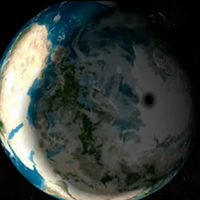

Of all the dramatic displays that nature treats us to, a total eclipse of the sun is the most awe-inspiring. It begins with a gradual darkening of the sky that progresses to an eerie gray. It’s strangely quiet, prompting people to speak just above a whisper as they watch a flat, black disk slide slowly across the sun. The moment when the last crescent of sunlight vanishes is unnerving, recalling ancient fears that an eclipse was signaling the end of the world. Then suddenly the sun’s corona bursts forth—a shimmering halo of light that seems to surround a black hole in the sky. This is the magic moment; this is why eclipse chasers are willing to travel to the ends of the earth. Then the moon moves on, uncovering a sliver of sunlight, and everyone cheers the sun’s return.
The Exploratorium’s eclipse expedition team has chased its fair share of total solar eclipses—seven so far—Webcasting these magnificent events to people around the world. While we won’t be traveling to this year’s eclipse, we’re providing links to other eclipse Web sites, and we’ll direct you to live Webcasts or broadcasts of the eclipse. We'll keep adding information, so check back here as the date approaches.
On this site
, you can watch archived Webcasts of previous eclipses, learn how to view an eclipse, read feature stories about eclipses, and much more!
The path of totality
At sunrise on July 22, 2009, (the evening of July 21 PDT), the moon’s umbra—the cone-shaped part of the moon’s shadow—will fall on India’s Gulf of Khambhat. The shadow will sweep across Asia and the South Pacific before leaving the earth near the Marshall Islands about 3½ hours later. The path of totality will cover a distance of approximately 9,500 miles (15,200 km). The maximum duration of totality is an exceptionally long 6 minutes and 39 seconds, which will come while the shadow is over the Pacific.
Some Times of Totality along the Eclipse Path
If you plan to watch a live Webcast of the eclipse (see links below), here are some times of totality:
01.15 UT—Western China
01.40 UT—Eastern China
01.55 UT—Ryukyu Islands, Japan
Use
Date and Time Help
to find how these times correspond to your local time.
(In the Bay Area, the time range is 6:15 p.m.–6:55 p.m. PDT on July 21.)
The eclipse Webcasts should begin considerably before totality, so you might want to check in about an hour early (00.15 UT) to see if a program has begun.
Webcasts
Grupo Saros (China - Wuhan) http://www.saros.org/index.htmlEclipse City (China - Shanghai) http://www.eclipse-tv.com/
Live! Eclipse 2009 (Japan) http://www.live-eclipse.org/
SEMS-Sun Earth Moon Systems (University of North Dakota): http://sems1.cs.und.edu/~sems/index.php
For more information
Live weather map (China) http://www.fjqx.gov.cn/weather/satellite.aspNASA Eclipse Website: http://eclipse.gsfc.nasa.gov/eclipse.html
Mr. Eclipse: http://www.mreclipse.com/MrEclipse.html
Eclipse Chaser: http://www.eclipsechaser.com/
World Map of Future Eclipses: /eclipse/future.html
Date and Time Help: http://www.timeanddate.com/worldclock/converter.html
Eclipse Chasers
Features Exploratorium senior physicist Paul Doherty, the happy veteran of many eclipse chases, and showcases the 1900 eclipse photography technique of Charles Burckhalter, the first director of the Chabot Space and Science Center.
Eclipse Chasers from KQED Public Media.
|
|

|
|
|
|
|
|
|
|

|
|
Got an image of a solar eclipse or eclipse event? How about a favorite sun-watching or shadow-watching activity? We invite you to share your images relating to eclipses and solar observation with the Exploratorium Eclipse Flickr Group .


